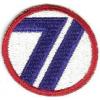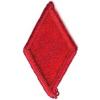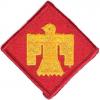Всесвітня військова енциклопедія
> США
> Нашивки
> Нарукавні нашивки Сухопутних військ
> Піхота
> US-INPTUS-00121

Нарукавний знак 198 піхотної бригади СВ США
Випадкові:

Нарукавний знак Командування повітряних перевезень

Мотопехотнои бригады «Железный Волк» Вооружённых сил Литвы первы вариант

Нарукавний знак 10 корпусу СВ США
Змінити інформацію
Description
On a blue shield arched at top and base 3 inches (7.62 cm) in height and 2 inches (5.08 cm) in width overall a stylized tongue of flame (shaped like an “S” reversed) yellow and scarlet with a portion of a rifle barrel with fixed bayonet all in white issuing diagonally from lower right to upper left and crossing over the flame all with a 1/8 inch (.32 cm) white border.
Symbolism
Blue and white are the colors used for Infantry. The tongue of flame alludes to the unit’s fire power and the bayonet, a basic Infantry weapon, is symbolic of carrying the fight to the enemy. The flame and bayonet together thus refer to the unit’s spirit and readiness to engage the enemy in fire fight or in hand-to-hand combat with the bayonet.
Background
The shoulder sleeve insignia was approved on 6 July 1967. (TIOH Dwg. No. A-1-462)
On a blue shield arched at top and base 3 inches (7.62 cm) in height and 2 inches (5.08 cm) in width overall a stylized tongue of flame (shaped like an “S” reversed) yellow and scarlet with a portion of a rifle barrel with fixed bayonet all in white issuing diagonally from lower right to upper left and crossing over the flame all with a 1/8 inch (.32 cm) white border.
Symbolism
Blue and white are the colors used for Infantry. The tongue of flame alludes to the unit’s fire power and the bayonet, a basic Infantry weapon, is symbolic of carrying the fight to the enemy. The flame and bayonet together thus refer to the unit’s spirit and readiness to engage the enemy in fire fight or in hand-to-hand combat with the bayonet.
Background
The shoulder sleeve insignia was approved on 6 July 1967. (TIOH Dwg. No. A-1-462)
Ще з цієї категорії: Піхота
 Нарукавний знак 71 піхотної дивізії СВ США
Нарукавний знак 71 піхотної дивізії СВ США
 Нарукавний знак 29 піхотної дивізії СВ США
Нарукавний знак 29 піхотної дивізії СВ США
 Нарукавний знак 5 піхотної дивізії СВ США
Нарукавний знак 5 піхотної дивізії СВ США
 Нарукавний знак 205 піхотної бригади СВ США
Нарукавний знак 205 піхотної бригади СВ США
 Нарукавний знак 45 піхотної бригадної тактичної групи СВ США
Нарукавний знак 45 піхотної бригадної тактичної групи СВ США

